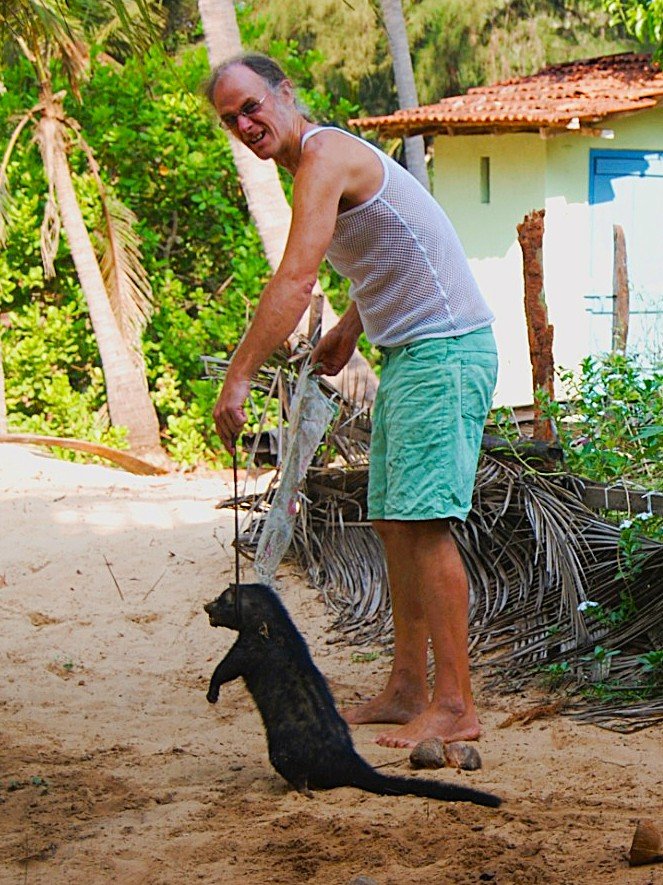Week 9 Wildlife in the garden
a few years ago it was not unusual to have a special nocturnal visitor in our garden at night. since then there has been a lot of local tourism related development thereby replacing a good portion of the nearby dense tree growth with huts and flower gardens and such. so sadly it is less likely that we will see any such visitors in our garden again.
our visitor, a solitary Asian palm civet (Paradoxurus hermaphroditus) used to come at night and feast on our chikoos, cashew apples or mangoes, whatever was in season. we let it feed as we were very happy to have the secretive wild animal present. it was nothing like the packs of monkeys which occasionally invade and help themselves to inordinate amounts of the fruit. at the time we were never quite sure what animal it was we could sometimes hear it and when we flashed a light we couldn't make out much of the animal because of it's dark color and camouflage but it's eyes shone bright. the local people called it a katander so we suspected it was a palm civet.
then one night we heard a terrible screech and then silence. we didn't go out to see what happened but in the morning we found the stiff dead body under a cashew tree. there are a couple of electric wires passing through the top of the cashew tree. birds, squirrels, ants and others perch or traverse the wires safely but if anything touches the two wires at the same time they get a terrible shock. the palm civet did just that and fell lifeless from the tree.

our dog was very curious about this fallen newcomer and crows were pecking at the corpse so i was quick to move and bury the animal. i used a hooked iron rebar leftover from building our house to move it. from the photo you can see the size of the unfortunate creature is about like a large domestic cat. it was surprisingly light. i buried it deep in the sand and covered it so the dog couldn't dig it up.

this is the animal producing the famed kopi luwak said to be the world's most expensive coffee. the civet eats and partially digests prime coffee cherries. the digestive process breaks down the fleshy pulp of the cherries but only ferments and alters the chemistry of the seeds (beans) giving them a supposedly smoother flavor. while the producers and vendors of the stuff claim the process is an improvement, coffee connoisseurs generally regard the product as merely a novelty item of little interest.
this bizarre processing method began after Dutch colonists introduced coffee plantations in Indonesia. the coffee was grown for export and the local workers were prohibited from keeping any of the harvest. eventually they noticed that palm civets, locally known as luwaks ate the cherries but when defecated the seeds (beans) remained largely in tact. when cleaned they resembled the beans the resentful workers were not allowed. so they learned to roast the beans and evade the colonial restriction. over time this evolved into the exclusively priced Kopi Luwak

the peculiar scientific name-Paradoxurus hermaphroditus derives from the placement and appearance of the perineal scent glands that both males and females use for scent marking, communication and identification of other individuals in females as well as males the glands resemble testicles
Sending you some Ecency curation votes!
thanks a lot. consistent ecency curations help a lot.
!INDEED
It's always a pleasure!
!INDEED
Ah, that's a really interesting history of the civet coffee - I've had it before in Vietnam but couldn't understand the fuss. Amazing you had an encounter with one. A shame it had to die, but I understand that people need to protect their crops! Great story for the #hivegardenqotw, @eolianpariah2 !
Thanks so much for your contribution to the #hivegardenQOTW. The community appreciates your insights, inspiration & engagement with all of us in the Hive Garden!
The HIVE GARDEN COMMUNITY supports gardening, homesteading, cannabis growers, permaculture and other garden or botanical related content. Delegations to the curation account, @gardenhive, are welcome! Find our community here!
thanks for the nice comment. the wires that the civet touched are electric supply to our house and garden. they are not meant to harm any animals so it was an unfortunate accident. best wishes
!INDEED